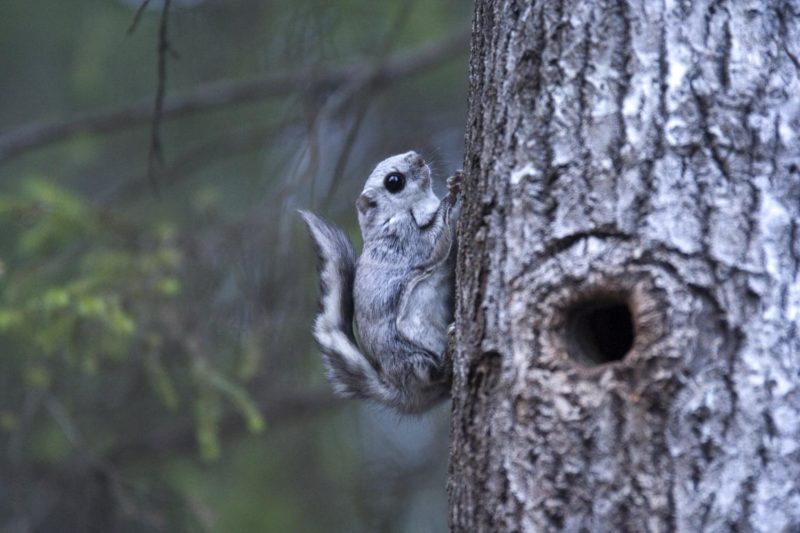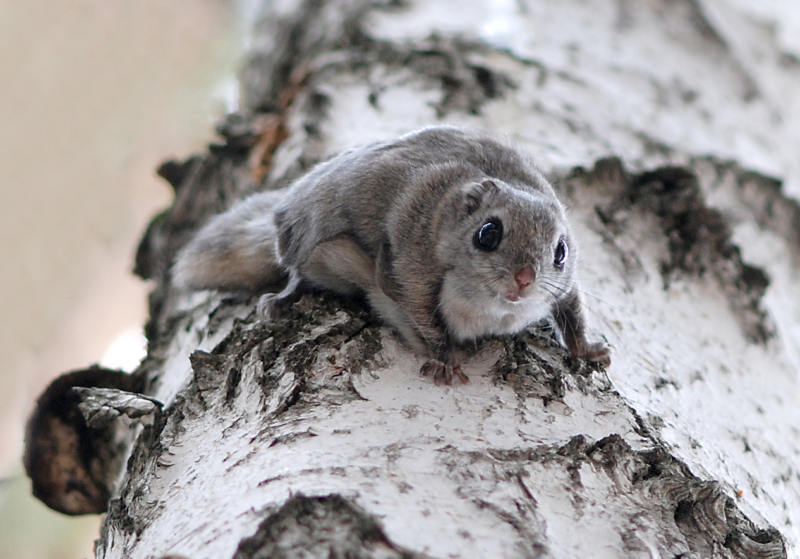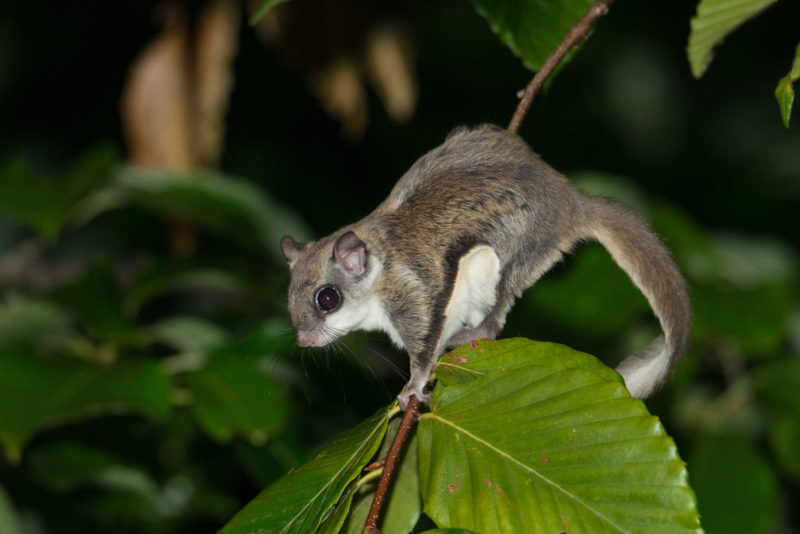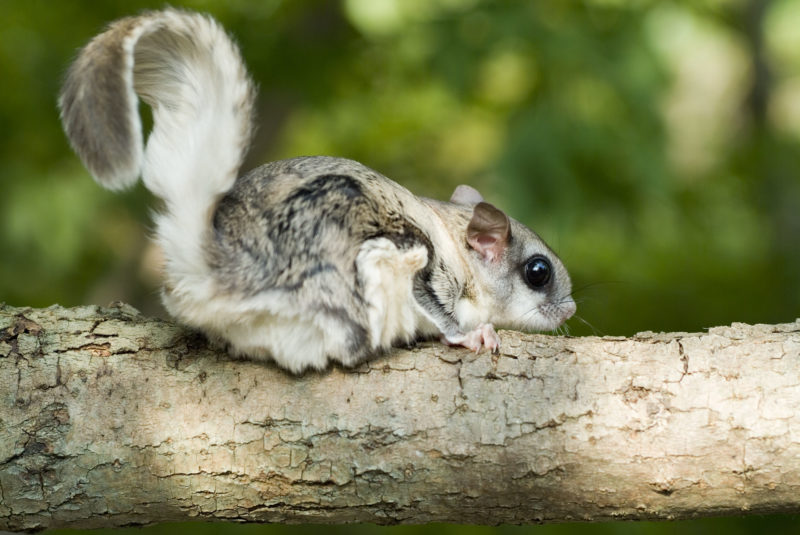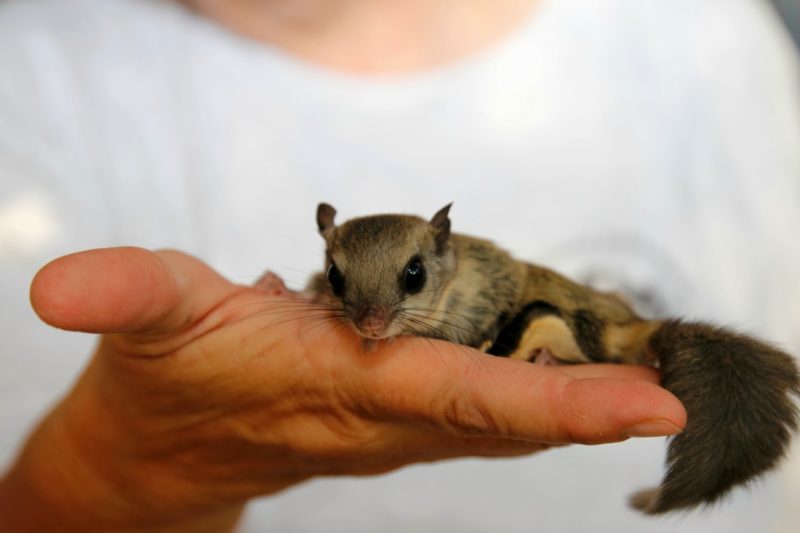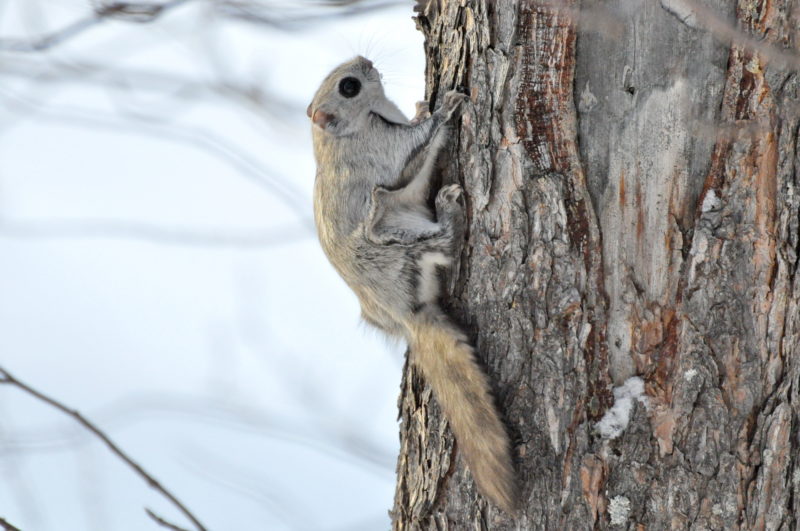This amazing animal easily plans between the trunks of deciduous trees in the woods, although it does not have wings. The common squirrel is the only representative of the squirrel family, a subfamily of squirrels in Russia. Nature rewarded her with special skin membranes, which, like a hang glider, hold a tiny body in the air.
Material Content:
Short description
Flying squirrels are very graceful, their hair is soft and silky. They got their name for the ability to fly from tree to tree. The membrane, which is located between the front and rear limbs, allows them to plan, flying a distance of up to 90 m. They can control their flight - make sharp turns at an angle of 90 °.
It is difficult to confuse a flying squirrel with an ordinary squirrel, a brief description will help to verify this:
- The fur of the animal is fluffy, very soft, the front and hind legs are connected by a leather fold.
- The tail is large and fluffy, slightly lighter in color than the back, with a "comb" in the middle.
- Males have a body length of up to 23 cm and a weight of up to 180 g, females are slightly smaller.
- Small round muzzle is decorated with rounded ears without tassels and large black eyes.
- Hind tarsus slightly longer than fore tarsus.
Shedding occurs 2 times a year: the summer ocher-gray coat changes to a lush winter coat, painted in all shades of gray. In accordance with the peculiarities of coloring, there are 10 subspecies of flying squirrels.
Animal habitat
Deciduous light forests of temperate climate - the main habitat of ordinary flying squirrels. They can live in mixed and alpine forests where there are tall hardwoods.Willingly settle in thickets of alder near swamps and along river banks. Hollows for nesting and wintering are found at an altitude of 2.5 to 10 m, sometimes they occupy the woodpecker housing.
In the vastness of Siberia, flying squirrels are found in ribbon bores, formed after the ice age, and in bright birch groves. Rarely settles in coniferous forests, preferring tall trunk larch trees.
Lifestyle and habits
Flying squirrels rarely descend to the ground. Most of their lives pass in the upper tier of deciduous or mixed forest. Here they feel safe: it is not so easy for a ground predator to catch a beast.
Animals are very secretive: they lead a nocturnal lifestyle, during the day they sleep in a nest. The gray color of the fur helps them merge with tree trunks at dusk. To make a jump, they climb to the top of a tall tree and, pushing off their hind legs, plan along an arcuate trajectory in the desired direction. Instead of “steering,” the animals use the tail. They can change the direction of flight and slow down if necessary. Approaching the landing site, flying squirrels take an upright position, cling to a tree with their claws and quickly run across to another part of the trunk. Such dexterity helps them escape from birds of prey.
What volatile proteins eat
For the winter, alder and birch catkins are stored in the nest of squirrels in the nest; they willingly eat young needles and shoot tops, various nuts and cone seeds. Sometimes they bite the bark of young trees - willow, birch, maple, alder.
In the summer, the diet is replenished with plant foods - young tree buds, fresh fruits and berries, forest mushrooms. Some flying squirrels were seen eating bird eggs and freshly hatched chicks. The diet depends on the habitat, for example, animals living in the northeast of the range prefer larch buds over all other feeds.
Reproduction, abundance and protection
The mating season begins in April and lasts until June. The female usually arranges a nest in a hollow; she can use birdhouses for birds. Pregnancy lasts a little over a month. In spring, offspring of 2 or 4 naked squirrels are born, late broods are born in late June.
Newborn squirrels are blind and naked, weigh about 7 g, have a body length of up to 5 cm, and a tail of about 1.5 cm. The first month they feed on mother’s milk, need heating, so flying squirrels rarely leave their offspring. The male settles nearby in a separate hollow. After about a month and a half, the babies under the supervision of their mother begin to leave the nest and try to make their first planning jumps. By the end of the second month of life, squirrels completely switch to an adult diet and live independently.
Young squirrels often winter together with adults in one hollow. In case of danger, the mother desperately defends the brood. A year after birth, squirrels create their families, reaching puberty.
In nature, the number of flying squirrels is small. They are caught for keeping at home and in order to obtain fur. The animal has no industrial value. The Red Book of several regions of Russia and other countries classifies the flying squirrel as a rare, endangered species that needs protection.
Human interaction
The animal is successfully kept in captivity, it is easily tamed, attached to a person. Living in an apartment, a flying squirrel wakes up at night and goes to bed only in the morning. This mischievous naughty seldom sits in one place, its activity after sunset can bring discomfort to the owners. Sometimes an animal adjusts its biorhythms to a person and switches to a daily lifestyle at home.
For proper development, proteins need a lot of calcium, so they can be fed with cottage cheese. Watermelons and other juicy, sweet fruits eagerly eat pets. During the day, they rest in a large cage with a shelter in the form of a birdhouse, dry branches, ladders, a feeder and a drinking bowl. In nature, animals live 5-8 years, at home - up to 13 years.
A cage with flying squirrels is placed away from central heating batteries and window glass, from which direct sunlight can get. At home, the animals do not give offspring, they need a large seasonal temperature difference. For breeding squirrels are kept in closed, spacious enclosures on the street.
This rodent of the squirrel family is much more sociable than ordinary squirrels; it easily makes contact with a person without being aggressive. Only females during mating season and while feeding offspring differ in nervous behavior. The animal eats the proposed food, clutching in its front legs, as in the hands. For food that needs to be given daily, 2 feeders are installed in the cage - for grain and succulent feeds, as well as drinking bowls for water. Nursing proteins are given milk with vitamin and mineral supplements. Bunches of fresh branches are hung up daily - this is the main food of flying squirrels.
Interesting facts about flying squirrel
Unlike ordinary squirrels, flying squirrels do not sleep in winter. When it is very cold, they sit in the hollow, eating on stocks made from autumn. A nest lined with moss and dry grass from the inside retains heat. Friendliness also helps the squirrels to warm themselves - in one place for the wintering several animals are often arranged.
You can learn about the presence of a secretive flying squirrel nearby by the special low chirping that it emits in the night forest.
Curious young squirrels that climbed into the branches and nursing females can sometimes be seen in the forest during the day. It’s better to plant a little squirrel under the feet of a child who is poorly planned on a tree branch: his family somewhere nearby will watch what is happening and take care of the baby as soon as you leave.
A cute flying squirrel beast can live at home if appropriate conditions are created for it. When there is no way to arrange an aviary or put a large cage for the animal, it is better not to start it.


